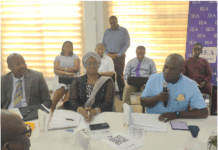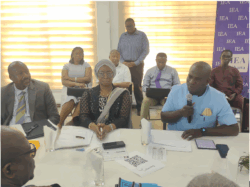Eleven consecutive days of torrential rain, starting on October 1st 2019 in Ghana’s Upper East Region, left a trail of deaths, destruction of buildings and farmlands in its wake. According to Ghana’s National Disaster Management Organization (NADMO), the heavy downpour displaced close to 2,000 people, leaving 2 dead as a result of floods and 17 dead as a result of their houses collapsing on them, injuring 19 people over the period and also flooding and uprooting dead bodies in cemeteries in some area. About 1,500 homes were destroyed by the floods, 844 hectares of farmland was left under water in all fifteen districts and municipalities in the region. In all, some 26,083 people, 10,890 of them children, have been rendered homeless following the continuous rainfall in the Upper East Region over the month of October.
It is also reported that on the last day of the month of October, torrential rain left about 100 houses in Western Region submerged under water from an overflow of the Ankobra River. Some of the towns along the catchments of the River, including Himan and Ankobra in the Prestea Huni-Valley Municipality were flooded with several properties worth thousands of Ghana Cedis destroyed, with affected the families seeking refuge in some classrooms and churches within the communities.
Monday October 28th will go down in Ghanaian history as the day one of the most reliable getaway routes “the Accra-Tema Motorway” during heavy rains joined the list as a flood-prone stretch. The rainfall in the capital and some parts of the country resulted in the submersion of several areas including the Tetteh-Quarshie Interchange, the Airport Junction as well as the 37 Military Hospital Bus Stop areas. The Accra-Tema motorway which serves as the main route for residents of Tema, Spintex, Ashaiman, among other places was left stranded after the downpour, as both sides of the motorway were overtaken by the ravaging flood thus bringing traffic to a halt from both ends for several hours. Rains in the Ashanti Region on same day also resulted in the death of a nine-year-old boy; bringing to 11 the loss of lives of children to different floods in the region within a month-and-a-half, according to the NADMO.
Hours of heavy downpour on Wednesday 30th October also left most communities in the Central Region submerged, leaving many inhabitants stranded. The long hours of rain resulted in floods that covered gutters and bridges in most areas in the Cape Coast Metropolis and Komenda-Edina-Eguafo-Abrem (KEEA) Municipality. Communities such as Abura, Pedu, Adisadel, Amamoma, Apewosika, the University of Cape Coast (UCC) campus, Abena in Elmina, as well as farms and schools were all affected; compelling management of the UCC to suspend lectures to prevent any casualties. The rains also flooded some parts of Winneba in the Central Region, destroying several household properties and displacing some residents, with others experiencing a difficult time accessing their rooms as both the interior and exterior of their houses were filled with floodwater.
A four year old boy drowned in the river while crossing with his friend on Wednesday October 16th after a heavy downpour in Torgodo in the Yilo Krobo Municipality. Friday 18th October rains resulted in a mudslide on the Adenta-Aburi road, causing a section of the major road to be blocked, and resulting in gridlock along the Peduase – Ayi Mensah stretch. A three-day heavy downpour got certain parts of Enchi in the Aowin Municipality of the Western North Region flooded and rendered hundreds of residents homeless. A 7-hour downpour on 4th October destroyed some 50 homes, displacing some 1,200 residents of Asuboni Rails in the Kwahu West Municipality of the Eastern Region, according to NADMO.
And the list goes on…….
Bleak Climate Reality
October remains a-month-to-remember due to the torrential rains recorded over the period. The expected October lighter rains which is usually absent, was replaced with heavy downpours.
Ghana has basically two rain seasons. The heaviest rain in the south is from April until June, while in the north, the season is continuous, giving rain from April until October. Lighter rains are however possible during September and October in Ghana’s south. Although the October lighter rains is usually absent, that has not been the case in 2019 as the country experienced heavy rains.
Although the Ghana Meteorological Agency has ruled out climate change as the reason why Ghana is experiencing rains in October, many Ghanaians have concluded so, from the change in weather patterns experienced over the month; a period not known to produce such rains and devastations. The heavy downpours and its attending floods have been occasioned in the month of October despite the earlier assurance given by the GMA in July this year that the possibility of flooding caused by rainfalls within Southern Ghana will be extremely low.
The destruction of personal effects, farms, livestock, stored food and houses, the destruction of houses and displacement of residents, the cancellation of appointments, the uprooting of dead bodies by the floods, the heavy traffic, and the loss of lives et cetera within the month, have awaken Ghanaians to the harsh reality of climate change.
Today, Ghanaian see climate change as a big deal, manifesting itself within the human experience. But there are contrasting views of a climate of constant change and volatility, and citizens and politicians alike are finally starting to catch on.
Climate Change
“Climate change” is described as the complex and long-term shifts in the planet’s weather conditions identified in temperature, precipitation, wind and other climate systems, and caused by “Global warming”; the unusual rapid increase in average global temperatures due to the greenhouse effect (Nunez, 2019; Riebeek, 2010). Generally speaking, carbon dioxide (CO2), Nitrious Oxide and other greenhouse gases (GHGs) in the atmosphere entrap part of the outgoing solar radiation, thereby raising the earth’s temperature. This natural “greenhouse effect’’ ensures that our planet (earth) remains habitable and maintains a balanced temperature (Darkwah et al, 2018).
The increasing levels of anthropogenic (human-caused) greenhouse gas concentrations in our atmosphere, the most abundant of which is carbon dioxide (CO2), and which is constantly being released through respiration, plant decomposition and the burning of fossil fuels, is the major contributor to climate change (Amuakwa-Mensah, 2014), aside the natural greenhouse effect which warms Planet Earth enough to sustain life, thanks to gases in the planet’s atmosphere that hold heat by acting like a blanket insulating the earth (Vyas 2019). That is to say that the more greenhouse gases emission into the earth’s atmosphere, the warmer the average temperature gets.
Over the past couple of centuries, the earth’s atmosphere has seen dramatic increases of CO2, Nitrious Oxide and other GHG, particularly from burning fossil fuels like coal, oil and to a lesser extent, natural gas. Uncontrolled industrialization processes, deforestation, transportation and even buildings release GHG onto the atmosphere (Benneth, 2017; Mgbemene, 2011). This means that anytime we turn on the gas or charcoal stove, cut down the trees, turn on the lights, heats our homes, and travel by car, train, aero plane et cetera, we contribute to global warming and climate change.
Climate Change Effects
It might sound trivial when we hear about global average temperatures changing by two or three Degrees. However those small-sounding numbers could have far-reaching and/or unpredictable environmental, social, and economic consequences.
The Food and Agriculture Organization (2009) notes that climate change negatively affects the basic elements of food production such as soil, water and biodiversity, and affects the stock of fish and their habitats. Warmer temperatures influence the fish stock, migratory patterns and mortality rates of wild fish stocks and also determine what species can be farmed in certain regions (Dontwi et al. 2008). The climatic variability effects on crops and fish have social and economic consequences for individuals whose livelihood depend heavily on the weather and climate (Al-Hassan & Poulton, 2009).
According to the World Bank (2014), women are more susceptible to the impacts of climate change as a result of a combination of factors including gender-based cultural norms, inheritance structures and household responsibilities. Nelson and Agbey (2005) finds a strong relationship between climate and poverty levels, and suggesting that poverty increases vulnerability to the negative effects of the environment conditions in the form of natural resource base, ecological fragility, access to safe water and sanitation.
Studies have also confirmed the link between climate change variability and human health. According to Hainesa et al. (2006), changes in climatic conditions are expected to affect the distribution of morbidity and mortality through the physical effects of exposure to high or low temperature.
Through climate change, some regions are experiencing extreme rainfalls leading to flooding, while other areas experiencing a decrease which leads to drought conditions. And while global mean temperatures are expected to increase between 1.4 and 5.8 degree Celsius by the end of this century, there would be a corresponding rise in sea level as glaciers and sea ice melts (IPCC, 2007); shifting rain and snow fall patterns, and setting animals on the move.
Although rain and snowfall has increased across the globe on average, yet some regions are experiencing more severe drought conditions, increasing the risk of wildfires, lost crops, and shortage of drinking water. Freshwater is projected to be less available, since glaciers is said to hold about three-quarter of the world’s freshwater (IPCC, 2007).
Written by Paa Kwasi Anamua Sakyi, Institute for Energy Security ©2019
The writer has over 22 years of experience in the technical and management areas of Oil and Gas Management, Banking and Finance, and Mechanical Engineering; working in both the Gold Mining and Oil sector. He is currently working as an Oil Trader, Consultant, and Policy Analyst in the global energy sector. He serves as a resource to many global energy research firms, including Argus Media and CNBC Africa.










